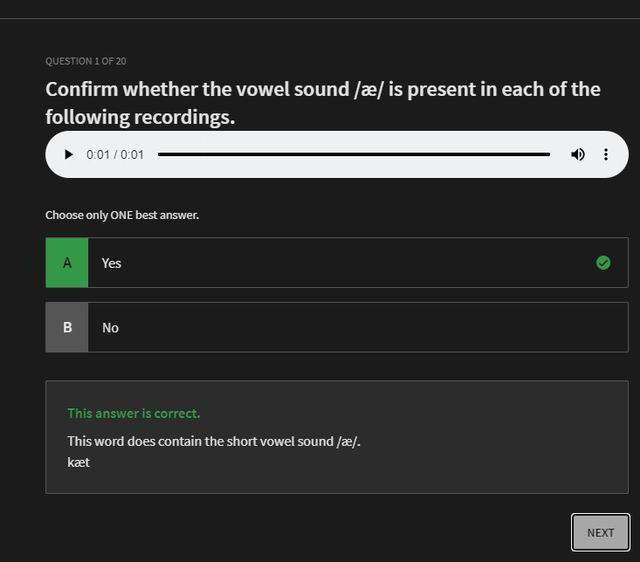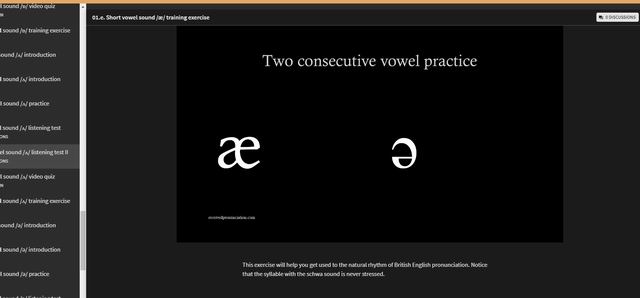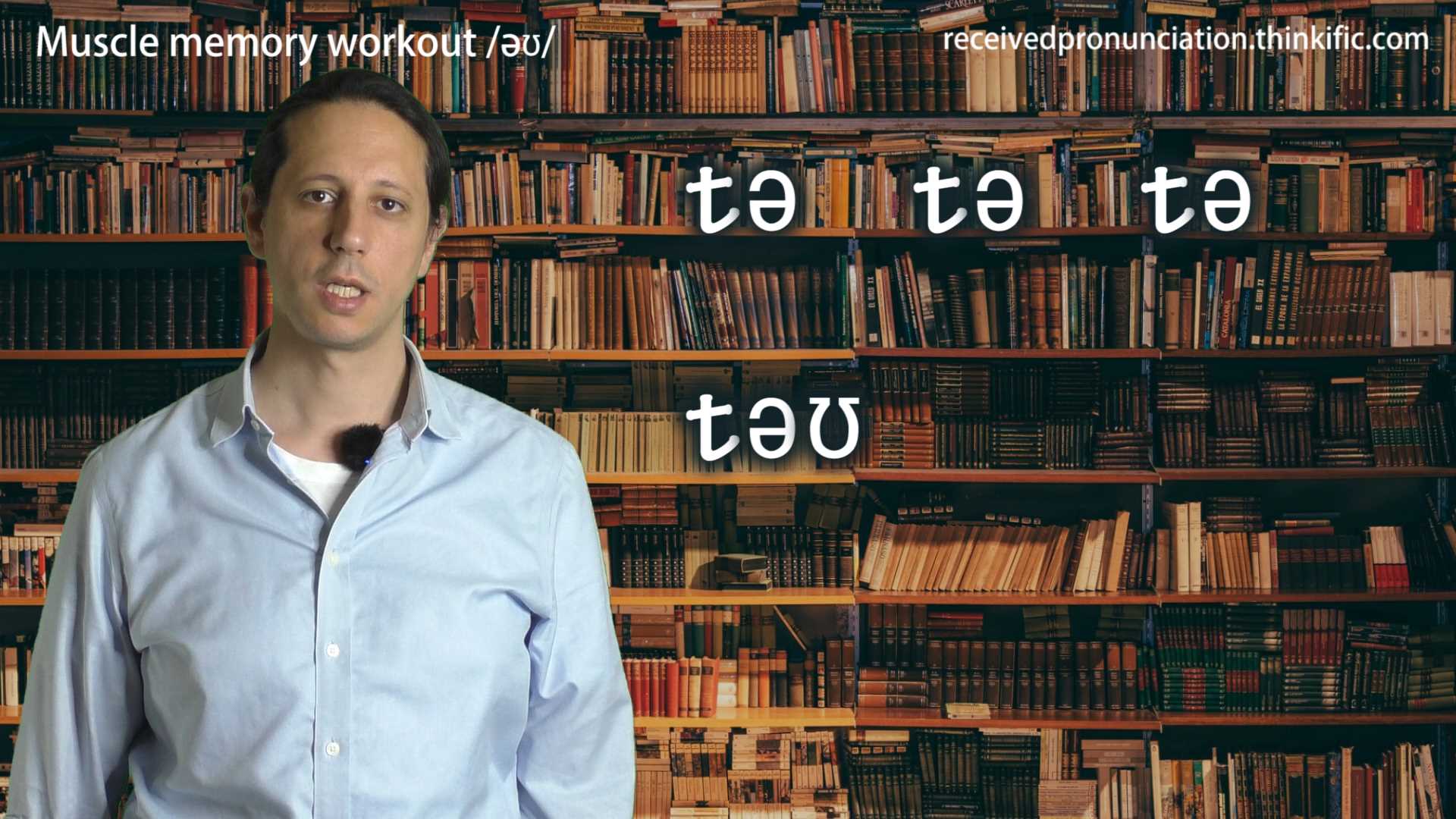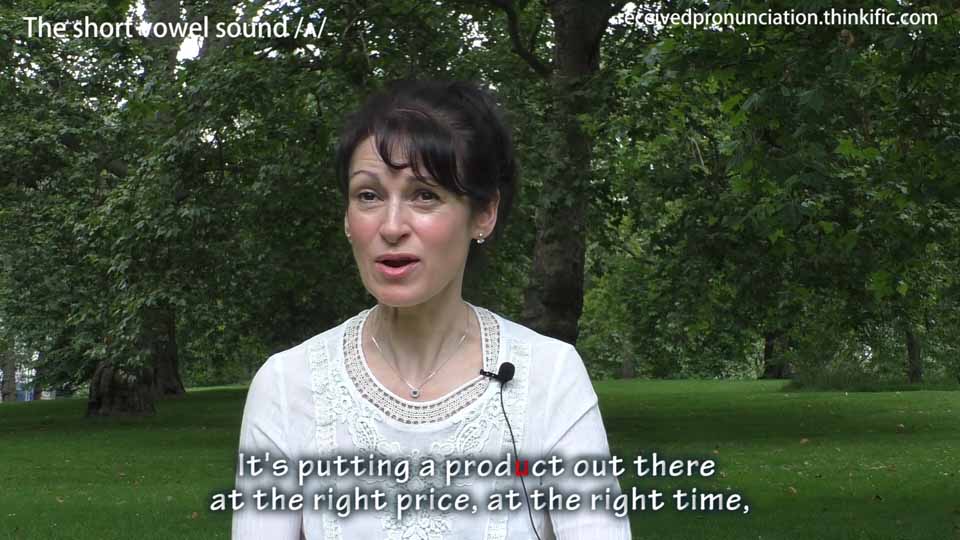- Details
- Written by Anton
- Category: Online Course
- Hits: 15535
Do you want to speak with an accent that sounds more native-like? Learn Received Pronunciation, the accent spoken by BBC newsreaders, presenters, journalists, and the top British actors in Hollywood.
This comprehensive course includes over 300 lessons, covering the fundamentals of British English pronunciation. Learn the 20 vowel sounds, the 24 consonant sounds, and the rules of connected speech with step-by-step video tutorials and PDF documents. Reinforce your knowledge with interactive exercises and drills.

Chapter I starts with a general overview of the basic tools we will use to study Received Pronunciation: the International Phonetic Alphabet and the vowel sound charts. Unlike English spelling, the International Phonetic Alphabet gives us an accurate representation of each individual sound. The monophthong chart helps us identify the position of the tongue for each vowel sound.

In Chapters II, III & IV, we explore each vowel sound in more detail.
Where is the phoneme located on the chart?
Where do we position the tip of the tongue?
Which facial muscles are we using? How does it compare to other vowel sounds?
We'll delve into the unique sounds of British English that are not found in other languages. We'll highlight the differences between sounds that may seem similar but are not quite the same. This focus on small but significant details will help us sound more native-like.
We'll also examine the critical role of consonant sounds in British English pronunciation. Though it may seem straightforward, many non-native speakers find it challenging to articulate consonant sounds with the same clarity and depth as a native speaker. We'll explore how the interaction between the mouth, lips, tongue, and lungs plays a crucial role in producing clear and distinct consonant sounds.

In order to sharpen your recognition of the target sounds, this course offers numerous listening exercises. The interconnection between the input (listening) and output (pronunciation) mechanisms means that honing your ear will also improve your ability to articulate the sounds with better precision.
Our approach builds up gradually, beginning with single-syllable words and gradually progressing to more intricate sentence structures. These exercises will help you become attuned to the subtle differences in sounds you may not have previously noticed.
Before engaging in more hands-on pronunciation practices, it's crucial to first be able to identify, isolate, and differentiate individual sounds. This is a key aspect of the course.

Each section features a vowel training exercise. The exercise pattern displayed in the screenshot above combines the target sound with the schwa sound. These drills will assist you in becoming more familiar with the natural rhythm of stressed and unstressed syllables, a crucial aspect of Received Pronunciation.

Included in the course is a series of muscle memory workout exercises to help you train the articulators to become more adept at recreating the natural sounds of British English pronunciation.
Developing muscle memory is crucial in improving your accent because it allows you to automate the correct pronunciation of sounds. When you repeat the same exercises over time, your muscles will learn to respond in the right way without requiring conscious effort. This allows you to focus more on the meaning of what you are saying and less on the mechanics of pronunciation. As a result, you will be able to speak more confidently and naturally.
In addition, by developing muscle memory, you will be able to produce the sounds of British English pronunciation more consistently, even when speaking at a faster pace or in more complex sentences. This will make your accent sound more natural and increase your overall comprehensibility to native English speakers.

You'll also have access to clear and concise PDF documents complete with explanations and diagrams. As your skills progress, you'll encounter increasingly complex exercises and drills.
For any questions, you can directly reach out to me through the discussion forum.
 |
 |
Experience unique video content featuring up-and-coming actors and business experts speaking with a natural British RP accent. Observe the sounds highlighted during their conversations.
This course has been created based on feedback I have received from my students who come from a wide range of linguistic backgrounds. I also recommend this course for those who wish to study on their own. The average completion time for this course ranges between 30-60 hours. Sign up today and master Received Pronunciation!
Get a free preview before making a purchase, and enjoy video tutorials with English, Japanese, and Russian subtitles (where available).
Start your journey to a perfect British accent by visiting https://receivedpronunciation.thinkific.com/courses/british-english-pronunciation-received-pronunciation or explore our other courses at https://receivedpronunciation.thinkific.com/collections.
- Details
- Written by Anton
- Category: Online Course
- Hits: 25164
Basic Course Structure
|
Course content |
|
International Phonetic Alphabet |
|
Understanding the use of vocal cords, shaping of mouth and lips |
|
Vowels: short vowels, long vowels, diphthong vowels, triphthong vowels |
|
Consonants: Plosives, fricatives, affricates, nasals |
|
Connected speech: Use of syllables, semi-vowels, combining various vowel and consonant sounds |
Lesson Structure for Beginner Students (40 minutes)
|
Advanced |
Time |
|
Warm-up |
5 minutes |
|
Study basic phonemes |
15 minutes |
|
Study connected speech (shadowing) |
10 minutes |
|
Sentence practice |
10 minutes |
Approx 12-15 lessons required to complete basic course. Number of lesson varies depending on student’s ability.
Lesson Structure for Advanced Students (40 minutes)
|
Beginner |
Time |
|
Warm-up |
5 minutes |
|
Review basic phonemes |
5 minutes |
|
Review connected speech (shadowing) |
10 minutes |
|
Dictation |
5 minutes |
|
Reading & speech practice |
15 minutes |
Contact for more information.
- Details
- Written by Anton
- Category: Online Course
- Hits: 17621
Learning to speak like a native English speaker may seem like a challenge, but with the correct mindset and dedication, it can be done.
Do people often fail to understand you even though your grammar is correct? Do you wish to speak English with a more native-like accent that is easy for people to understand? Perhaps you can write grammatically correct sentences, but when it comes to conversation you fail to leave the right impression due to poor pronunciation and intonation.
Whether you are a business person involved in high-stakes negotiations or a student giving presentations, communicating clearly and effectively is essential.
The aim of this course is to give non-native English speakers the necessary tools and knowledge to help them improve their English pronunciation.
Students are guided step-by-step using carefully prepared materials with a clear and concise structure to help them improve regardless of their level. With practice, patience, and the right mindset, it can be done.
Enhance your English pronunciation skills with my 40-minute lessons, designed for maximum effectiveness and efficiency. My accelerated learning techniques, including timed repetition and shadowing, will help you achieve a natural British accent.
- Discover the International Phonetic Alphabet to better understand the sounds of English, and learn to adopt the correct mindset for mastering Received Pronunciation.
- Develop the correct muscle memory required for native-like pronunciation, and differentiate between similar sounds such as /ʌ/ and /ə/.
- Understand the crucial role of semivowels in connected speech, as well as the interconnection between your articulators and diaphragm.
- Recognize the impact of your mother tongue on your English pronunciation, and learn to think like a native speaker for effortless communication. Establish neural pathways for more fluent English speech.
Maximize your learning potential by also enrolling in my comprehensive course program. Schedule a complimentary 20-minute consultation with me at private_tuition @receivedpronunciation.co.uk (remove the space after the @ sign) and receive a prompt response within 24 hours.
Don't forget to check your junk email folder! Fill out this form to secure your consultation.
Accent reduction for Americans is available here.
FAQ
Can I really change my accent?
It can be done, but it requires a fundamental understanding of the mechanics of how we create sounds. We have to consider the positioning of the articulators and how we aspirate air from the lungs. For some, this can be a simple process, yet for others, it can be extremely challenging. Each student progresses at their own pace. Some can struggle with the very basic articulation of sounds while others can easily mimic the sounds and just need to develop better overall awareness. With the right mindset and patience, it can be done.
How many lessons do you recommend?
I recommend a minimum of 10-15 lessons to master the fundamentals. You will better understand why your accent differs and what changes need to be made. This course focuses on giving students the ability to self-diagnose without always having to rely on a teacher. My lessons also include The Daily Training Program at no extra cost.
How will the complete course materials benefit my lessons?
The Complete Course is a program that was specifically crafted to better assist students when they enroll in private lessons. It’s more than just a course. Think of it as a virtual textbook complete with pre-recorded videos, PDFs, quizzes and repetition exercises. The course materials are input-focused which saves time and enables the lessons to become more output focused. An explanation can be found here: Thinkific Pronunciation Course
Do I need to purchase the course materials to take lessons?
While the purchase of the materials is not compulsory, students who enroll generally improve at a much more advanced rate than those who don’t. As a teacher, it also helps me better gauge your progress and troubleshoot any difficulties you encounter. Students who do not purchase the course materials will still be given free access to The Daily Training Program.
How much time do I need to put into this?
In general, I recommend one private lesson a week together with 10-15 minutes a day spent on the training materials. Those who study at a steady pace with a long-term outlook achieve the best results.
Can I purchase the materials without taking lessons?
Yes, anyone is welcome to enroll in the Complete Course materials. There is also a discussion panel where you can freely submit questions.
How frequently should I take lessons?
The frequency of lessons depends on the student’s preference. Most students request to take lessons once a week.
What will I learn during my first few lessons?
The initial lessons will focus on laying the foundations. While it's easy to mention concepts like the use of stressed and unstressed syllables or the aspiration of sounds from the front of the mouth, understanding the practical implications and application is crucial.
We will study the mechanisms that enable the native-like aspiration of sounds. You'll engage in drills designed to help you articulate the fundamental sounds, much like a baby learning to use speech mechanisms for the first time. Emphasis will also be placed on maintaining a relaxed posture when producing the neutral sounds of British English. Step-by-step guidance will be provided, ensuring a comprehensive understanding of the process that allows for the execution of unstressed sounds without overcompensation. We'll explore how to avoid engaging certain facial muscles incorrectly and positioning the tongue inaccurately.
Remember, the ultimate goal is to cultivate a native-like pronunciation without sounding forced. Instead, the focus is on learning to articulate the sounds effortlessly. While this transformation won't occur overnight, grasping these fundamental principles is essential for sustained progress in your pronunciation journey.
Do you offer lessons for native English speakers?
Yes, the teaching methods for native English speakers differ. Please contact me for more information.



